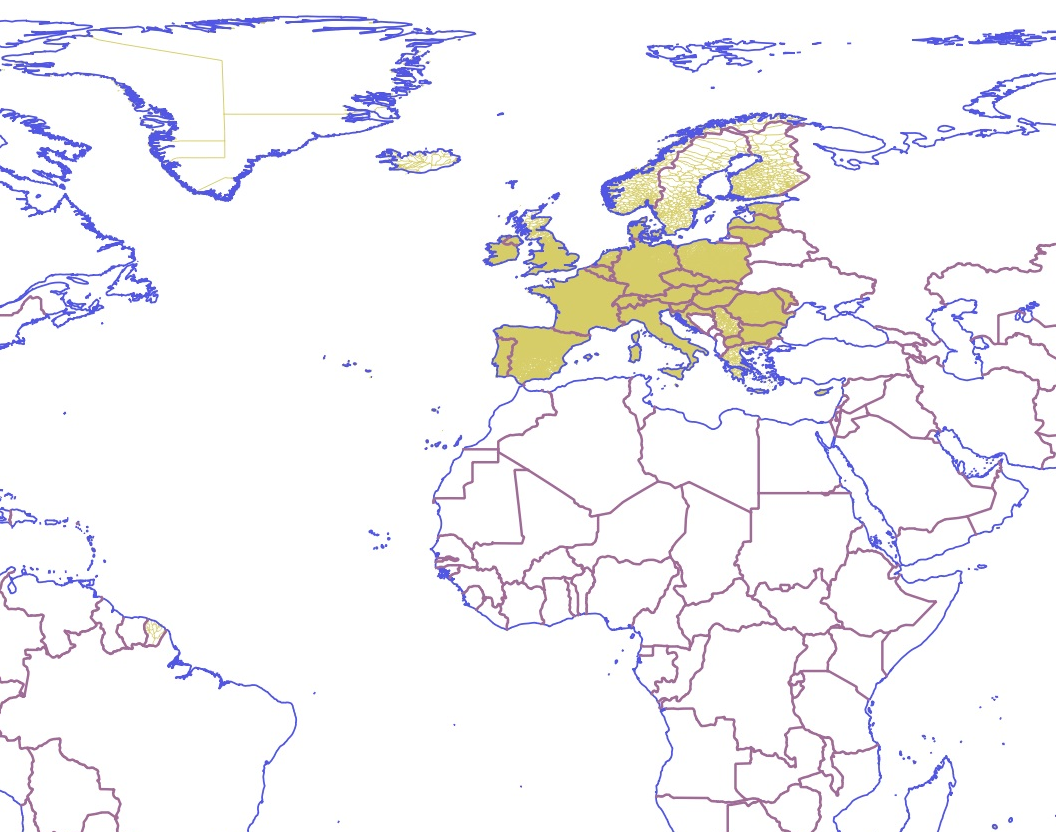CSV
Type of resources
Available actions
Topics
INSPIRE themes
Keywords
Contact for the resource
Provided by
Years
Formats
Representation types
Scale
-
Data fra Kystdirektoratets vejrmålere.
-

GISCO (Geographic Information System of the COmmission) is responsible for meeting the European Commission's geographical information needs at three levels: the European Union, its member countries, and its regions. In addition to creating statistical and other thematic maps, GISCO manages a database of geographical information, and provides related services to the Commission. Its database contains core geographical data covering the whole of Europe, such as administrative boundaries, and thematic geospatial information, such as population grid data. Some data are available for download by the general public and may be used for non-commercial purposes. For further details and information about any forthcoming new or updated datasets, see http://ec.europa.eu/eurostat/web/gisco/geodata. This metadata refers to the whole content of GISCO reference database extracted in June 2020, which contains both public datasets (also available for the general public through http://ec.europa.eu/eurostat/web/gisco/geodata) and datasets to be used only internally by the EEA (typically, but not only, GISCO datasets at 1:100k). The document GISCO-ConditionsOfUse.pdf provided with the dataset gives information on the copyrighted data sources, the mandatory acknowledgement clauses and re-dissemination rights. The license conditions for EuroGeographic datasets in GISCO are provided in a standalone document "LicenseConditions_EuroGeographics.pdf". The database is provided in GPKG files, with datasets at scales from 1:60M to 1:100K, with reference years spanning until 2021 (e.g. NUTS 2021). Attribute files are provided in CSV. The database manual, a file with the content of the database, a glossary, and a document with the naming conventions are also provided with the database. The main updates with respect to the previous version of the full database in the SDI (from Jul. 2018) are the addition of the following datasets: - Administrative boundaries at country level, 2020 (CNTR_2020) - Administrative boundaries at commune level, 2016 (COMM_2016) - Coastline boundaries, 2016 (COAS_2016) - Exclusive Economic Zones, 2016 (EEZ_2016) - Farm Accountancy Data Network based on NUTS 2016, 2018 (FADN_2018) - Local Administrative Units, 2018 (LAU_2018) - Nomenclature of Territorial Units for Statistics, 2021 (NUTS_2021) - Political regions (NB.: defined by the Committee of the Regions), 2018 (POLREG_2018) - Pan-European Settlements, 2016 (STLL_2016) and 2018 (STLL_2018) - Transport Networks (NB.: railway lines, railway stations, roads, road junctions, levelcrossings, ferry routs and custom points), 2019 (TRAN_2019) - Urban Audit Areas, 2018 (URAU_2018) and 2020 (URAU_2020) NOTE: This metadata file is only for internal EEA purposes and in no case replaces the official metadata provided by Eurostat. For specific GISCO datasets included in this version there are individual EEA metadata files in the SDI: NUTS_2021 and CNTR_2020. For other GISCO datasets in the SDI, it is recommended to use the version included in this dataset. The original metadata files from Eurostat for the different GISCO datasets are available via ECAS login through the Eurostat metadata portal on https://webgate.ec.europa.eu/inspire-sdi/srv/eng/catalog.search#/home. For the public products metadata can also be downloaded from https://ec.europa.eu/eurostat/web/gisco/geodata. For more information about the full database or any of its datasets, please contact the SDI Team (sdi@eea.europa.eu).
-
Dødsårsager for personer døde i Danmark med gyldigt CPR-nummer og bopælsadresse i Danmark.
-
Omdriftsarealet summeret på sogn.
-
Besætningers placering på baggrund af CHR den 1. juni det pågældende år. For hver besætning er beregnet antal dyreenheder ud fra normtal fra gældende Husdyrgødningsbekendtgørelse.
-
Kortet viser placeringen af de økologiske marker ved udgangen af 2015, der er fuldt omlagte, under omlægning eller planlagt at skulle omlægges til økologisk jordbrugsproduktion. Af kortet kan man dog ikke se om marken er fuldt omlagt eller under omlægning til økologisk produktion. Attributtabellen indeholder bl.a. et EjerNr., som er et fortløbende nummer, der bruges til at identificere de marker, som tilhører samme ansøger.
-
Kortet viser placering af adressen for ansøgere, som har søgt om grundbetaling og/eller anmeldt marker i Landbrugsstyrelsens Fællesskema for det pågældende år. Ansøger er i visse tilfælde et advokatfirma eller anden selskabskonstruktion med adresse i en by, derfor viser kortet ikke entydigt hvor landbrugsejendommene er placeret. Ansøgere er angivet som enten planteavlere eller husdyrbedrifter og grupperet efter hvor mange hektar som de har anmeldt. Hobbybedrift (< 25 ha), deltidsbedrift (25-50 ha), heltidsbedrift (50-250 ha) og stordrift (> 250 ha). Planteavlere er de ansøgere, som i CHR (Det centrale Husdyrbrugsregister) har anmeldt et antal husdyr, der svarer til under 5 dyreenheder. Ydermere indeholder datasættet oplysning om ansøger er autoriseret til økologiske jordbrug i det pågældende år. Det har ikke været muligt at identificere de økologiske bedrifter for alle årene så den oplysning mangler for 2010 og 2011. Attributtabellen indeholder bl.a. et BedriftNr., som er et ID nummer, der bruges til at identificere unikke ansøgere.
-
Kortet viser udviklingen for perioden 2010 – 2017 i antallet af ansøgere på sogn, som har søgt om grundbetaling og/eller anmeldt marker i Landbrugsstyrelsens Fællesskema. Datasættet indeholder også supplerende oplysninger om det gennemsnitlige anmeldte areal (hektar) for ansøgerne på sogneniveau. Datasættet giver en indikation af strukturudviklingen i landbruget i forhold til udviklingen i antallet af ansøgere og hvor mange hektar der gennemsnitligt bliver anmeldt på sogn for hver ansøger. Da ansøgere også kan være et advokatfirma eller anden selskabskonstruktion med adresse i en by viser kortet ikke entydigt udviklingen i landbrugsejendomme og hvor de er placeret.
 RUC Geo-Data catalogue
RUC Geo-Data catalogue